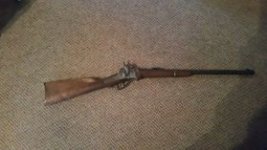Jimmya1742
Inactive
Okay, here is my story. My grandparents on my mother's side were country folk who never went anywhere out of their small town during the week and only on special occasions on the weekends. When I was 17, they made a special trip on a Wednesday specifically to give me a gun he had picked up when he was in the navy in WWI. Two weeks later my grandmother passed and he passed two weeks after her, making this gun a very special gift to me. Of course this gun will never be sold in my lifetime, but I would like to know it's history. It is a New Model 1863 Sharps carbine, serial number C29137. If anyone has a copy of Civil War Sharps Carbines & Rifles, Coates, Earl J. & McAulay, John D., I would greatly appreciate any info you could relay to me, or for that matter, anyone that could relate any known history of this firearm. Thanks in advance for any info.
Attachments
Last edited:

